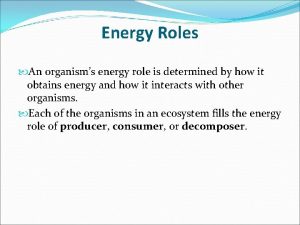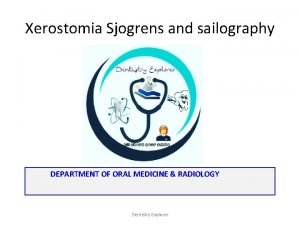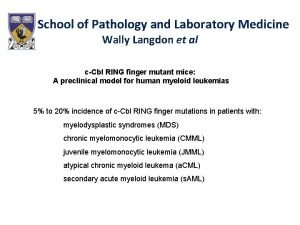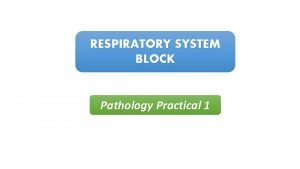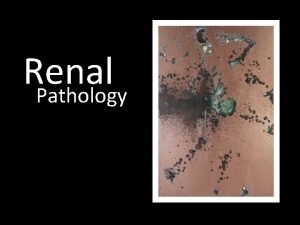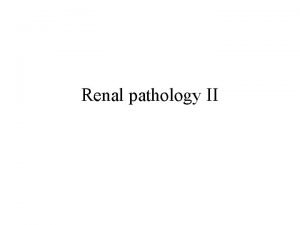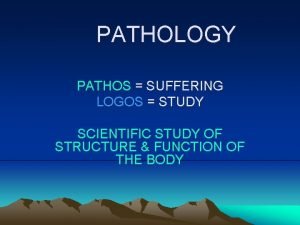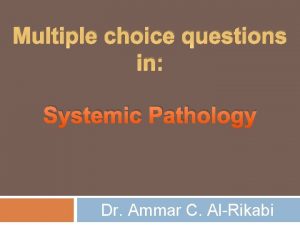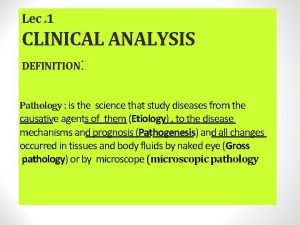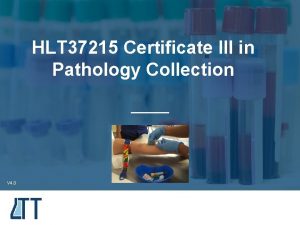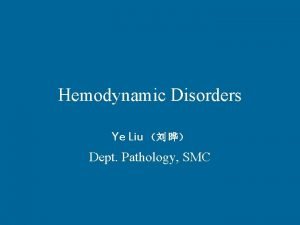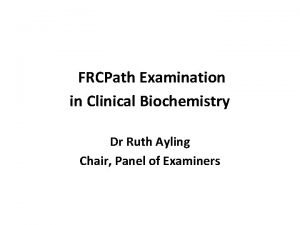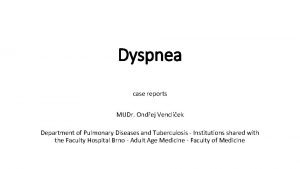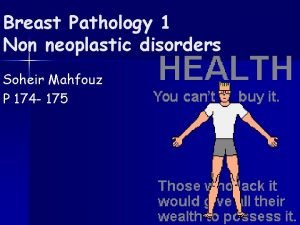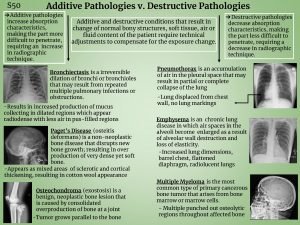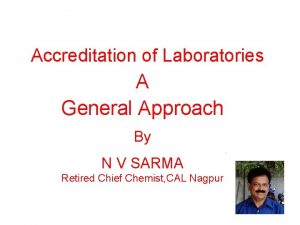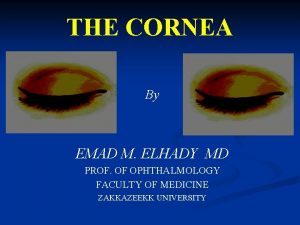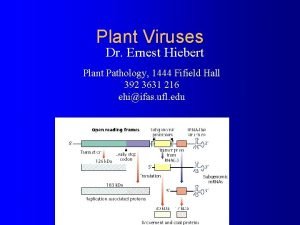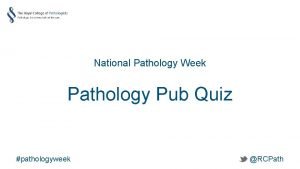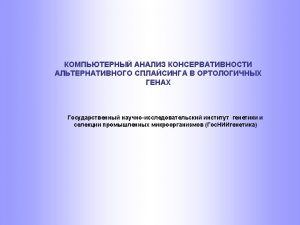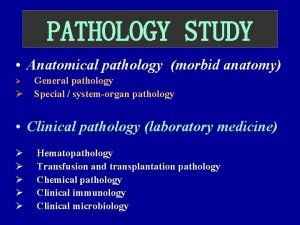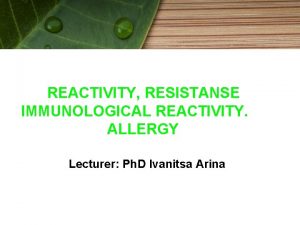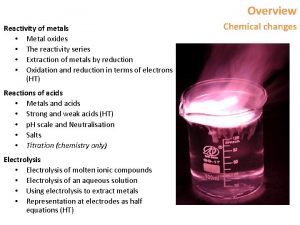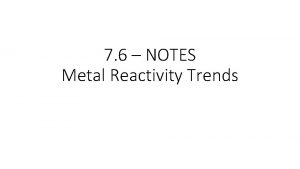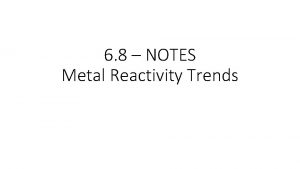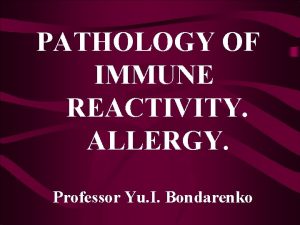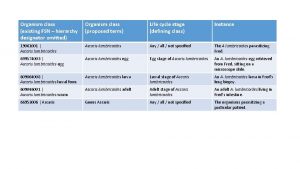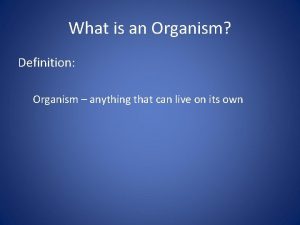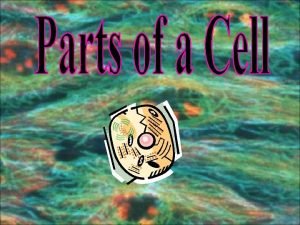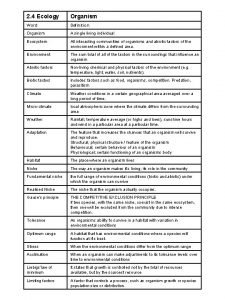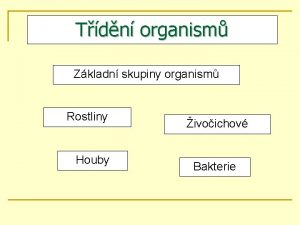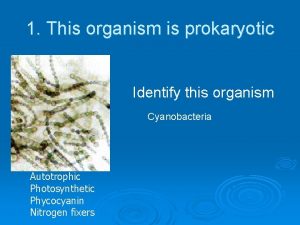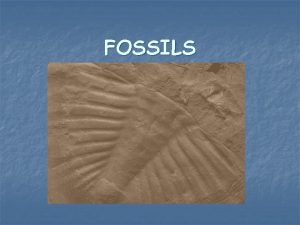Organism reactivity Role of reactivity in human pathology








































- Slides: 40

Organism reactivity. Role of reactivity in human pathology Ph. D. , M D. Nataliya Potikha

DEFINITION OF THE NOTION “REACTIVITY” § Reactivity is the organism ability to change functional activity of the systems and organs for the organism adaptation in new vital conditions of the environment and, finally, for the survival. § The concept “reactivity” is common to the concept “resistance”.

DEFINITION OF THE NOTION “RESISTANCE” § Resistance is a stability state of an organism in the condition of pathogenic factors influence.

CLASSIFICATION of THE RESISTANCE § - ACTIVE (appears in the result of organism § § § adaptation to damage factor) - PASSIVE (caused by anatomy-physiological peculiarities of every organism) - PRIMARY (congenital) - SECONDARY (acquired, which occurs during the whole life, is changed ) - UNSPECIFIC (is the opposition to the influence of many pathological agents ) - SPECIFIC (is the opposition to the influence of the recognised agent (microorganism), results from the immune system activation )

CLASSIFICATION of THE “REACTIVITY” Biological result s from the morphological and physiological peculiarities of all individuals, which are origined from some species sex age heredity Individual constitution environment SPECIFIC physiological regulative systems pathological - immunodepressive conditions - allergy UNSPECIFIC physiological pathological shock collapse narcosis

§ § Individual reactivity is determined by age, sex, heredity, constitution, and functional conditions of organism’s regulatory systems, external environmental influences. For example: some diseases arise only in infant organism (measles, roseola, small pox, rachitis, scarlet-fever) but not in adult’s one. Children are less adapted to sharp changes of air temperature, but infant organism is more resistant to the hypoxia (oxygen deficiency), than adults. Resistance of the old organism to the infection reduces, but the number of cancer-ill adults and atherosclerotic-ill increases. Old people have very slowly developing inflammatory reaction.

§ The dependence of the reactivity on sex can be explained by the morphological and physiological peculiarities of men and women. § Reactivity of a female organism varies during the menstrual cycle time, pregnancy, climax. Resistance of a women to the hypoxia, hunger, and bleeding is better, than men’s. § Women live longer, than men. But men are physically stronger.

§ Individual reactivity of an organism is realized by specific and unspecific mechanisms. § The specific mechanisms are formed by immune system. § There are physiological specific mechanisms and pathological ones. § The specific physiological mechanisms of the individual reactivity are the immune reactions, which form the specific resistance to some antigens (bacteries, viruses, fungus, tumours cells). § The pathological specific mechanisms of the individual reactivity can cause development of the immunodeficiency or immunodepressive conditions of an organism or the allergic reactions and diseases.

§ The unspecific mechanisms of the reactivity are physiological and pathological. § Physiological unspecific reactivity is the vital reactions complex of the healthy organism in normal life conditions. § Pathological unspecific reactivity is the complex of an organism’s reactions in abnormal life conditions as a result of the decrease of the adaptive potential of an organism (for example: shock, collapse, narcosis).

§ Mechanisms of the unspecific reactivity are realized by means of § nervous system reactions (central nervous system, vegetative nervous system), § endocrine system reactions; § barrier systems; § cell’s reactions; § humoral reactions.

§ The nervous and endocrine system are the main systems, which form the organism’s reactions on the various factors. § The nervous system changes activity of receptors, neurons, nervous fibres, spinal cord and brain in the new vital conditions. The alteration of the nervous system activity changes the organism resistance. For example, the extreme stimulation of the central nervous system by coffeine reduces the resistance of an organism to hypoxia. The psychic trauma complicates the disease course. § Reactivity of an organism depends on the vegetative nervous system conditions. Changes of adrenergic and cholinergic link of the vegetative nervous system activity, which always is counterbalanced in normal conditions, characterize the organism’s adaptation to some influences of environment. The stimulation of the sympathoadrenal system on the first stages of adaptation is a protective reaction. In pathological conditions (for example, continuous hypoxia) the cholinergic link of the vegetative nervous system activation increases of an organism resistance to hypoxia.

§ Endocrine system takes the certain part in forming of the individual reactive mechanisms, so its alteration can complicate life of the human. § The suprarenal gland function lessening reduces the resistance to hypoxia, hypofunction of the thyroid gland increases the resistance of an organism to hypoxia too, and the decrease of insulin excretion by pancreas elongates maim incarnation. § The role of endocrine system and nervous systems, that operate synergically, is possible to explain on the example of stress-reaction. § Canadian pathologist Selye was the first who has worked out the concept about stress. Stress is the unspecific reaction of an organism to different influences. Hypothalamus-hypophisis-suprarenal system plays the main role. This system carries out a general adaptive syndrome.

§ The barrier systems preserve an organism against the pathological factors of the external environment. § There are external and internal barriers.

§ The external barriers are skin, mucous membranes, liver, spleen, lymphatic nodes and other organs, which have the cells of the system of mononuclear phagocytes. § The skin is covered with multilayer epithelium. It is a barrier for the majority of microorganisms. The clean skin has bactericidal activity, which depends on the р. Н of the sweat, on the structure of a secret of grease glands, on the excretion of antiseptic products. § The mucous membranes, which cover conjunctiva, throat, respiratory, digestive and urogeninal tracts, prevent the penetration of microorganisms, due to the insignificant permeability. The secret of the mucous coat glands and active function of glimmer epithelium promotes the mechanical deleting of dust, microorganisms. The bactericidal substance lysocim, which destroys some microorganism’s species, and the immunoglobulines are in the mucous coats secret. Protective reflexes, such as cough, sternutation, and delay of breath have the large value too. The gastric juice has bactericidal activity too, for example, kills of the cholera vibrion. Vomiting reflex also has protective function.

§ There are internal barriers in the organism, which are named histohematic barriers. Wall of a capillary has the function of a barrier. The wall of a capillary lets in only the nutritious substances and does not let in the toxins, medicines. § Examples of internal barriers: § hematoencephalic (blood-brain), § hematoophtalmic (blood-eye tissue), § hematolabirintic (blood-lymph of a labyrinth), § hematoovarial (blood-ovarium tissue), § hematotestical (blood-testicular tissue), § placenta (mother’s blood-foetus blood).

§ Connective tissue, which surrounds the vessels and penetrates into a tissue, executes the protective function too. § The most powerful and complex barrier surrounds the nervous system and organs of reproduction. The nervous cells are the most sensitive to the internal environment changes. § The hematoencephalic barrier permeability is various in different sites of the central nervous system. § For example, hematoencephalic barrier in the area of hypothalamus lets pass all substances, which are in the blood. The information about the chemical structure of blood is necessary for the hypothalamus functions correction. The delay of the information can be dangerous for life.

§ Hematoencephalic barrier includes the endotelium of the brain capillaries, their basal membrane, the glia and the brain coats. § Hematoencephalic barrier structure: slots between endothelial cells of the capillaries are absent; glial cells cover all surface of the capillary; basal membrane is very dense. § The peculiarity of the hematoencephalic barrier structure promotes protection of the brain against the influence of toxic substances. But in some cases this property complicates the treatment of some diseases of the nervous system. The permeability of barrier amplifies when the temperature of body increases. Doctors use this property for the treatment of infectious diseases of the nervous system.

§ The protective function of barriers is dependend on nervous and humoral influences, on a state of the external and internal environment. § The alcohol has specific influence up hematoencephalic barrier. The permeability of this barrier increases during initial stage of alcoholism, so various toxic substances influence up the brain. Then permeability of the barrier decreases, that provokes violation of nutrition of the brain. Alcoholic psychoses, degradation of the person, premature aging develop in such patients. The alcohol easily damages reproductive system, poisons a foetus.

§ Cellular mechanisms of reactivity are manifested by the change of a functional state of a separate cell. § The main effect of various cells reactions is adaptation to the conditions of the life, which permanently change. § There are 2 types of adaptive cells reactions: immediate and continuous. § The immediate mechanisms of cellular adaptation arise at once after the influence of stimulator and are realized due to present mechanisms. The continuous mechanisms of cellular adaptation arise gradually after durablis or multiplis influences of stimulator. The durablis influence of any factor promotes accumulation of the defined information in a cell and inclusion of mechanisms of selfregulation. In a cell there is an interrelation of their function with the genetic apparatus. The increasing of influence functional load of cell strengthens activity of the genetic apparatus and promotes accumulation of some proteins, which must promote increasing of the function. § The example of durablis adaptation is hypertrophy of a body, hyperplasia of a body.

§ Humoral mechanisms of the reactivity are very important for the organism too. § The system of the plasma blood proteins, which is named system of complement, has the protective function. The system of complement and system of phagocytes have functional connection with immune system. § Humoral factors are start mechanisms of the reactivity due to their operation on organs-effectors. § The strongest substances are mediators and hormones. For example, the stress-reaction occurs due to the amplified excretion of norepinephrine (mediator), epinephrine (neurohormone), adrenotropic (hormon), glucocorticoids (hormones) and other substances.

§ Individual reactivity can be changed as a result of influence of the factors of the external environment. Reactivity of an organism depends on ecology. Some changes of an ecological situation can prevent development of disease; others on the contrary provoke development of disease. For example: the small doze of a ultra-violet irradiation increases resistance of an organism to the infectious diseases, promotes synthesis of vitamin D in the organism, and the large doze promotes development of skin burn.

§ The durablis operation of ionizing rays lowers resistance of an organism to infection. § The intensive physical load is accompanied by significant psychoemotional overload and can provoke development of cardiovascular pathologies. § The nonrational nutrition, hypovitaminosis lower resistance of an organism to an infection, promotes development of various violations of metabolism. § Reactivity of the person can be changed as the result of the influence of alcohol, nicotine, automobile gases, which contain CO, Hg, Pb, industrial wastes. § Sharp changes of weather, season of year and climate influence on reactivity and resistance too. Low temperature of air influences on organism variously. § The overcooling lowers resistance to the infection, so in such conditions influenza and pneumonia may occur. The short-term contact of a human body with the cold environment, which periodically repeats, increases resistance of an organism to the infection. § Low temperature (hypothermia) is used in medicine during complex continual operations on the heart and brain.

Influence of the age on individual reactivity Progeria (rapid ageing) Habitués of a child 2, 5 years old

Influence of the age on individual reactivity Progeria (rapid ageing) Verner’s syndrome (26 years old men)

PROGERIA (rapid ageing) Hutchinson-Gilford’s syndrome

PROGERIA (rapid ageing) Hutchinson. Gilford’s syndrome You see girl 13 years old (her weight – 10 kg)

Constitution It is a complex of functional and morphological peculiarities of an organism, which were derivated by the heredity, and which were formed during all life under the influences of the environment. It determines reactivity of every individual.

CONSTITUTIONAL TYPES BY SIGO respiratory digestive muscular brain

Constitutional types by KRECHMER athletic astenic digestive

Constitution al types by Hyppocrate Choleric Sanguinic Phlegmatic Melancholic Constitutiona l types by А. А. BOGOMOLETZ Asthenic Fibrosis Pastosis Lipomatosis

Constitutional types by Chornoruzkiy It is determined due to the size of costal arcs angle of a person § § § Normosthenic (90 degree) Hypersthenic (more than 90 degree) Asthenic (less than 90 degree)

DIATHESIS manifestation of the abnormal constitution, which is characterised by the abnormal reaction of an organism to the physiological and pathological influences 1. EXUDATIVE-CATARAL (very intensive exudative processes, allergy reactions and long disease course) 2. LYMPHOHYPOPLASTIC (muscular tissue is developed deficiently, the lymphatic nodes size is increased aytoallergic diseases arise in these patients very often) 3. NERVOUS-ARTHRITIC (obesity intensification, nervous system irritability, diseases of joints, skin diseases, psychological disorders in some patients) 4. ASTHENIC (adynamia; lability of vascular reactions and gastroptosis

Exudative-catharal diathesis

Mechanisms of the unspecific reactivity 1. REGULATIVE SYSTEMS а) nervous system reactions (central nervous system, autonomic nervous system- adrenergic and cholinergic link) б) endocrine system reactions (pituitary gland, thyroid gland, suprarenal glands ) 2. BARRIER SYSTEMS а) external (skin, mucous membranes, liver, spleen, lymphatic nodes, SMP) б) internal (Wall of a capillary has the function of a barrier: hematoencephalic , hematoophtalmic, hematolabirintic, hematoovarial, hematotestical, placenta) 3. CELL’S REACTIONS (change of a functional state of a separate cell) 4. HUMORAL REACTIONS (neurohormones, hormons, biologocal active substancies)

System of mononuclear phagocytes (SМP) IS THE SYSTEM OF CELLS, WHICH ARE UNITED DUE TO 3 FEATURES: 1. mutual derivation (all these cells derive from the stem cell of red bone marrow); 2. mutual function (all cells are phagocytes); 3. mutual structure (all these cells have one nuclear).

System of mononuclear phagocytes (SМP) CELLS LOCALIZATION CELL PRECURSORS Bone marrow PROMONOCYTES Bone marrow MONOCYTES Peripheral blood MACROPHAGES HISTIOCYTES Connective tissue KUPFFER’S CELLS Liver ALVEOLAR MACROPHAGES Lungs FREE and FIXED MACROPHAGES Spleen MACROPHAGES Bone marrow PLEURAL and PERITONEAL MACROPHAGES Serose cavities OSTEOCLASTES Bones MICROGLIAL CELLS Nervous system LANGERHANS’ CELLS Skin

macrophage lymphocyte

HUMORAL MECHANISMS of the REACTIVITY 1. SYSTEM of COMPLEMENT (has the protective function) 2. MEDIATORS of the HUMORAL SYSTEMS (biological active substances) 3. HORMONES

REACTIVITY DEPENDENCE from ENVIRONMENT

THANK YOU for ATTANTION!
 Food webs and energy pyramids answer key
Food webs and energy pyramids answer key An organism's energy role is determined by how it obtains
An organism's energy role is determined by how it obtains What is web role and worker role in azure
What is web role and worker role in azure Soziale identität krappmann
Soziale identität krappmann Statuses and their related roles determine
Statuses and their related roles determine Acts done with fear are voluntary
Acts done with fear are voluntary Applied psychology in human resource management
Applied psychology in human resource management Tree in winter appearance sialography
Tree in winter appearance sialography Define seed pathology
Define seed pathology Banff pathology course
Banff pathology course Job market for pathologists
Job market for pathologists Pathology outline
Pathology outline Diagnostic report sample
Diagnostic report sample Wally langdon
Wally langdon Pneumonia
Pneumonia Benign nephrosclerosis pathology outlines
Benign nephrosclerosis pathology outlines Acute tubular necrosis
Acute tubular necrosis Pathos pathology
Pathos pathology Systemic pathology questions and answers pdf
Systemic pathology questions and answers pdf Leeds virtual pathology
Leeds virtual pathology Clinical pathology meaning
Clinical pathology meaning Branches of pathology
Branches of pathology Certificate iii in pathology collections
Certificate iii in pathology collections Hemodynamic disorders pathology
Hemodynamic disorders pathology Ayling sanjaya
Ayling sanjaya Thyroiditis
Thyroiditis Clavulonate
Clavulonate Cumulus clouds in oral pathology
Cumulus clouds in oral pathology Chronic hyperplastic candidiasis
Chronic hyperplastic candidiasis Fibrocystic breast pathology
Fibrocystic breast pathology Pathology of asthma
Pathology of asthma Constructive pathology
Constructive pathology Nabl assessor list
Nabl assessor list Interlocking pathology
Interlocking pathology Clinical pathology accreditation
Clinical pathology accreditation Serpeginous
Serpeginous Data-centric pathology
Data-centric pathology Behavioral pathology
Behavioral pathology Plant pathology
Plant pathology Heptagon
Heptagon Clinical pathology accreditation
Clinical pathology accreditation

